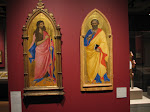



Angela Thigpen
AH 251
Metropolitan Museum of Art
February 17, 2009
I visited the Metropolitan Museum of Art, and overall had a good experience. I viewed many sculptures and exhibits, and would like to describe two life size marble sculptures that I found most interesting. First I will speak about the life size marble sculpture of Lucretia, by the artist Philippe Bertrand (1663-1704) which was carved during the Classical period. Bertrand was the son of a sculptor, and was well known for plaster over-mantels, bronze, and marble sculpting. The second marble sculpture that I chose is Perseus with the Head of Medusa, by the artist Antonio Canova (1757-1822) during the Neoclassicism movement. Canova was known as a talented carver of marble and also known as one of the greatest sculptors of his time in Europe. He was known for the Baroque and Rocco style sculpting. I was drawn to these life size marble sculptures because of the skilled details they both displayed.
AH 251
Metropolitan Museum of Art
February 17, 2009
I visited the Metropolitan Museum of Art, and overall had a good experience. I viewed many sculptures and exhibits, and would like to describe two life size marble sculptures that I found most interesting. First I will speak about the life size marble sculpture of Lucretia, by the artist Philippe Bertrand (1663-1704) which was carved during the Classical period. Bertrand was the son of a sculptor, and was well known for plaster over-mantels, bronze, and marble sculpting. The second marble sculpture that I chose is Perseus with the Head of Medusa, by the artist Antonio Canova (1757-1822) during the Neoclassicism movement. Canova was known as a talented carver of marble and also known as one of the greatest sculptors of his time in Europe. He was known for the Baroque and Rocco style sculpting. I was drawn to these life size marble sculptures because of the skilled details they both displayed.
Lucretia was known as a woman of virtue who was raped and took her own life because she was unable to live with the shame of the assault. Lucretia’s eyes are closed; her lips apparently show the gasping emotional and physical pain that she is feeling. The strands of Lucretia’s hair, and the ribbon tied around her head are skillfully carved. Her head is also titled to the side which is a sign of shame and despair. Her left breast is uncovered which may be symbolic of the assault, and the breast and nipple are detailed. The knife piercing Lucretia’s chest with each of her fingers carved and holding the handle of the knife is amazing. Her left hand rests on the bench supporting her weight.
Lucretia’s right arm is bent and the crease is carved at her elbow shows much detail. Her clothing is draped about her, and each of her legs is carved underneath her clothing. This marble sculpture appears so alive and lifelike. Although tragic this sculpture is a stunningly beautiful work of art.
Lucretia’s right arm is bent and the crease is carved at her elbow shows much detail. Her clothing is draped about her, and each of her legs is carved underneath her clothing. This marble sculpture appears so alive and lifelike. Although tragic this sculpture is a stunningly beautiful work of art.
The second piece of art that I chose is another larger than life marble sculpture of Perseus with the Head of Medusa. This skillfully carved marble statue speaks volumes: Perseus is displayed as valiant and strong, he stands tall; his posture is straight and erect. This is surely a sign of victory and triumph. I’m not sure if it matters that Medusa is already beheaded, but Perseus is able to look upon Medusa without fear, which no one has ever been able to do without turning to stone. Perseus’ head is turned to face his opponent, and his headgear and curly hair are also skillfully carved. His eyes, nose and mouth show how handsome Perseus was. The sculpting looks so life like; the structure and details of his neck, shoulders, and chest and down his torso, his navel, arms, wrist and fingers around his sword pulls you in and you feel as if you are an eyewitness to Medusa’s beheading. His male anatomy is also detailed, and his clothing is draped about him just so. The muscles in his calves and legs are so detailed as well as the lacing of his sandals.
Defeat appears to be the snake haired Medusa’s last facial expression after she was beheaded by Perseus. Medusa’s eyes, nose and mouth is skillfully carved and defeat is captured and skillfully displayed in this carving as Perseus shows off the spoils of victory.


These are both wonderful, monumental pieces you chose, Angela.... It is amazing that each of your chosen artists were able to imbue such flowing, sensuous and human qualities into a large block of very hard and dense stone using nothing more than hand tools. Classicism and Neo classicism revive the sensibility of Greek and Roman sculpture in its appreciation for the human form.....
ReplyDelete